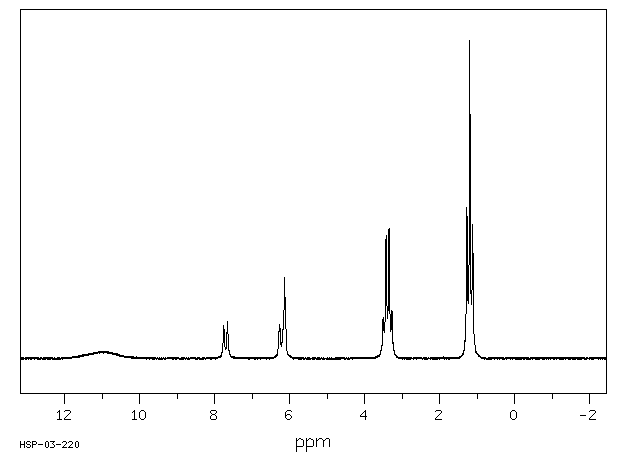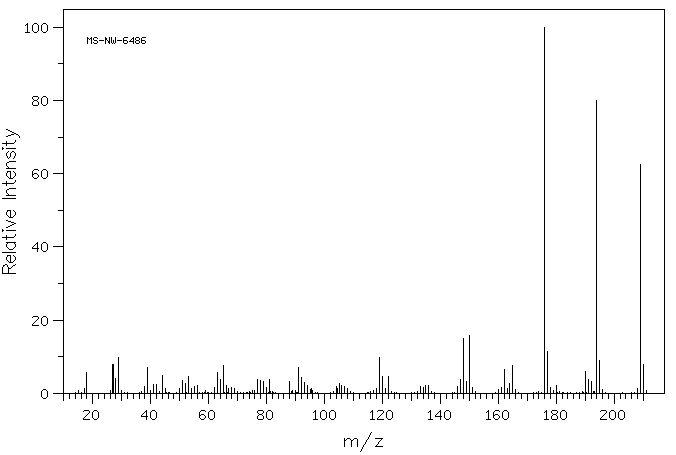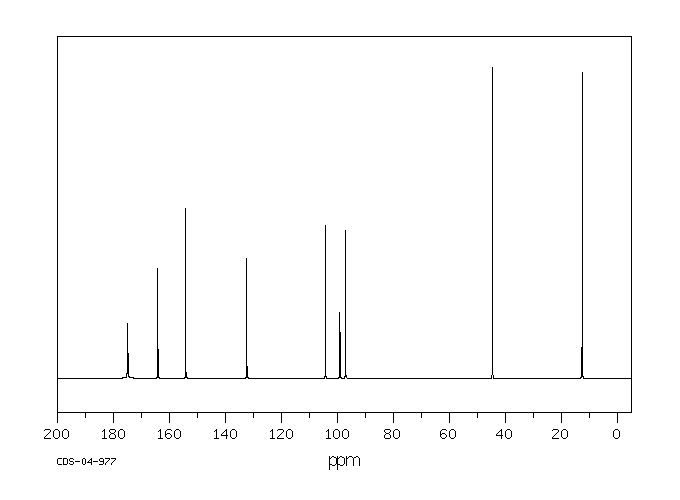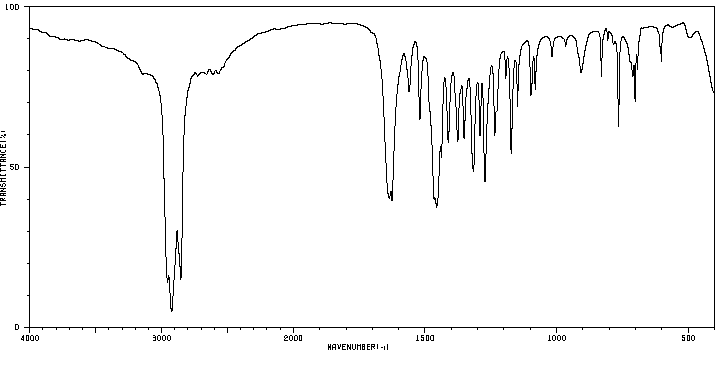4-二乙氨基水杨酸 | 23050-90-0
中文名称
4-二乙氨基水杨酸
中文别名
——
英文名称
4-(diethylamino)salicylic acid
英文别名
4-(diethylamino)-2-hydroxybenzoic acid;2-carboxy-5-(diethylazaniumyl)phenolate
CAS
23050-90-0
化学式
C11H15NO3
mdl
MFCD00044334
分子量
209.245
InChiKey
IZYRYLLQDKRMKK-UHFFFAOYSA-N
BEILSTEIN
——
EINECS
——
-
物化性质
-
计算性质
-
ADMET
-
安全信息
-
SDS
-
制备方法与用途
-
上下游信息
-
文献信息
-
表征谱图
-
同类化合物
-
相关功能分类
-
相关结构分类
计算性质
-
辛醇/水分配系数(LogP):2.8
-
重原子数:15
-
可旋转键数:4
-
环数:1.0
-
sp3杂化的碳原子比例:0.363
-
拓扑面积:60.8
-
氢给体数:2
-
氢受体数:4
安全信息
-
海关编码:2922509090
SDS
上下游信息
-
上游原料
中文名称 英文名称 CAS号 化学式 分子量 3-羟基-N,N-二乙基苯胺 3-diethylaminophenol 91-68-9 C10H15NO 165.235 -
下游产品
中文名称 英文名称 CAS号 化学式 分子量 —— N-(3-chlorophenyl)-4-(diethylamino)-2-hydroxybenzamide 693257-28-2 C17H19ClN2O2 318.803
反应信息
-
作为反应物:描述:参考文献:名称:一种苯并咪唑类hERG钾离子通道的小分子 荧光探针及其制备方法与应用摘要:本发明涉及一种苯并咪唑类hERG钾离子通道的小分子荧光探针及其制备方法与应用,该荧光探针的结构通式如式(Ⅰ)所示:式中,R1为羟基、卤素、烷基或烷氧基的单取代或多取代基;R2为荧光团;n=1‑6,所述R1为对位卤素;R2为香豆素类、萘二酰亚胺类、NBD类、Cy5类及异硫氰酸荧光素类荧光团。在hERG钾离子通道及其高表达的肿瘤细胞或组织标记中、在hERG钾离子通道抑制剂的高通量筛选以及在新药心脏毒性评价中以及在作为识别hERG钾离子通道的探针以及在hERG钾离子通道生理、病理及相关疾病研究中的应用。公开号:CN104910894B
-
作为产物:描述:参考文献:名称:Some Derivatives of 4-Amino-2-hydroxybenzoic Acid (p-Aminosalicylic Acid)摘要:DOI:10.1021/ja01147a006
文献信息
-
Salicylanilides as inhibitors of the protein tyrosine kinase epidermal growth factor receptor作者:Christoph Liechti、Urs Séquin、Guido Bold、Pascal Furet、Thomas Meyer、Peter TraxlerDOI:10.1016/j.ejmech.2003.09.010日期:2004.1pharmacophore model for ATP-competitive inhibitors interacting with the active site of the EGFR protein tyrosine kinase and a putative binding mode of 4-anilinoquinazoline suggest that a salicylic acid function could serve as the pharmacophore replacement of a pyrimidine ring. Superpositions by CAMM of salicylanilides with the potent EGFR tyrosine kinase inhibitor 4-[(3'-chlorophenyl)amino]-6,7-dimethoxyquinazoline
-
Design of irreversible optical nanothermometers for thermal ablations作者:Tiffany P. Gustafson、Qian Cao、Steven T. Wang、Mikhail Y. BerezinDOI:10.1039/c2cc37271a日期:——Nanothermometers composed from a gold nanorod core, temperature sensitive linker and fluorescent dye are reported. The nanothermometers have low fluorescence due to a self-quenching mechanism at temperatures below 50 °C and become highly fluorescence above 70 °C.
-
Astemizole Derivatives as Fluorescent Probes for hERG Potassium Channel Imaging作者:Beilei Wang、Zhenzhen Liu、Zhao Ma、Minyong Li、Lupei DuDOI:10.1021/acsmedchemlett.5b00360日期:2016.3.10imaging of hERG potassium channels in living cells can provide useful information for hERG-correlation studies. Herein, three small-molecule fluorescent probes, based on the potent hERG channel inhibitor astemizole, for the imaging of hERG channels in hERG-transfected HEK293 cells (hERG-HEK293) and human colorectal cancer cells (HT-29), are described. These probes are expected to be applied in the physiological
-
电致发光材料、电致发光材料的制备方法及发光器件
-
The Ferroquine Antimalarial Conundrum: Redox Activation and Reinvasion Inhibition作者:Faustine Dubar、Christian Slomianny、Jamal Khalife、Daniel Dive、Hadidjatou Kalamou、Yann Guérardel、Philippe Grellier、Christophe BiotDOI:10.1002/anie.201303690日期:2013.7.22health: Ferroquine is a ferrocene‐based analogue of the antimalarial drug chloroquine. In addition to the primary mechanism of quinoline action, fluorescent probe studies in infected red blood cells show another mechanism is at work. It is based on the production of HO. in the acidic and oxidizing environment of the digestive vacuole of the malaria parasite and implies that, with ferroquine, reinvasion
表征谱图
-
氢谱1HNMR
-
质谱MS
-
碳谱13CNMR
-
红外IR
-
拉曼Raman
-
峰位数据
-
峰位匹配
-
表征信息
同类化合物
(βS)-β-氨基-4-(4-羟基苯氧基)-3,5-二碘苯甲丙醇
(S,S)-邻甲苯基-DIPAMP
(S)-(-)-7'-〔4(S)-(苄基)恶唑-2-基]-7-二(3,5-二-叔丁基苯基)膦基-2,2',3,3'-四氢-1,1-螺二氢茚
(S)-盐酸沙丁胺醇
(S)-3-(叔丁基)-4-(2,6-二甲氧基苯基)-2,3-二氢苯并[d][1,3]氧磷杂环戊二烯
(S)-2,2'-双[双(3,5-三氟甲基苯基)膦基]-4,4',6,6'-四甲氧基联苯
(S)-1-[3,5-双(三氟甲基)苯基]-3-[1-(二甲基氨基)-3-甲基丁烷-2-基]硫脲
(R)富马酸托特罗定
(R)-(-)-盐酸尼古地平
(R)-(-)-4,12-双(二苯基膦基)[2.2]对环芳烷(1,5环辛二烯)铑(I)四氟硼酸盐
(R)-(+)-7-双(3,5-二叔丁基苯基)膦基7''-[((6-甲基吡啶-2-基甲基)氨基]-2,2'',3,3''-四氢-1,1''-螺双茚满
(R)-(+)-7-双(3,5-二叔丁基苯基)膦基7''-[(4-叔丁基吡啶-2-基甲基)氨基]-2,2'',3,3''-四氢-1,1''-螺双茚满
(R)-(+)-7-双(3,5-二叔丁基苯基)膦基7''-[(3-甲基吡啶-2-基甲基)氨基]-2,2'',3,3''-四氢-1,1''-螺双茚满
(R)-(+)-4,7-双(3,5-二-叔丁基苯基)膦基-7“-[(吡啶-2-基甲基)氨基]-2,2”,3,3'-四氢1,1'-螺二茚满
(R)-3-(叔丁基)-4-(2,6-二苯氧基苯基)-2,3-二氢苯并[d][1,3]氧杂磷杂环戊烯
(R)-2-[((二苯基膦基)甲基]吡咯烷
(R)-1-[3,5-双(三氟甲基)苯基]-3-[1-(二甲基氨基)-3-甲基丁烷-2-基]硫脲
(N-(4-甲氧基苯基)-N-甲基-3-(1-哌啶基)丙-2-烯酰胺)
(5-溴-2-羟基苯基)-4-氯苯甲酮
(5-溴-2-氯苯基)(4-羟基苯基)甲酮
(5-氧代-3-苯基-2,5-二氢-1,2,3,4-oxatriazol-3-鎓)
(4S,5R)-4-甲基-5-苯基-1,2,3-氧代噻唑烷-2,2-二氧化物-3-羧酸叔丁酯
(4S,4''S)-2,2''-亚环戊基双[4,5-二氢-4-(苯甲基)恶唑]
(4-溴苯基)-[2-氟-4-[6-[甲基(丙-2-烯基)氨基]己氧基]苯基]甲酮
(4-丁氧基苯甲基)三苯基溴化磷
(3aR,8aR)-(-)-4,4,8,8-四(3,5-二甲基苯基)四氢-2,2-二甲基-6-苯基-1,3-二氧戊环[4,5-e]二恶唑磷
(3aR,6aS)-5-氧代六氢环戊基[c]吡咯-2(1H)-羧酸酯
(2Z)-3-[[(4-氯苯基)氨基]-2-氰基丙烯酸乙酯
(2S,3S,5S)-5-(叔丁氧基甲酰氨基)-2-(N-5-噻唑基-甲氧羰基)氨基-1,6-二苯基-3-羟基己烷
(2S,2''S,3S,3''S)-3,3''-二叔丁基-4,4''-双(2,6-二甲氧基苯基)-2,2'',3,3''-四氢-2,2''-联苯并[d][1,3]氧杂磷杂戊环
(2S)-(-)-2-{[[[[3,5-双(氟代甲基)苯基]氨基]硫代甲基]氨基}-N-(二苯基甲基)-N,3,3-三甲基丁酰胺
(2S)-2-[[[[[((1S,2S)-2-氨基环己基]氨基]硫代甲基]氨基]-N-(二苯甲基)-N,3,3-三甲基丁酰胺
(2S)-2-[[[[[[((1R,2R)-2-氨基环己基]氨基]硫代甲基]氨基]-N-(二苯甲基)-N,3,3-三甲基丁酰胺
(2-硝基苯基)磷酸三酰胺
(2,6-二氯苯基)乙酰氯
(2,3-二甲氧基-5-甲基苯基)硼酸
(1S,2S,3S,5S)-5-叠氮基-3-(苯基甲氧基)-2-[(苯基甲氧基)甲基]环戊醇
(1S,2S,3R,5R)-2-(苄氧基)甲基-6-氧杂双环[3.1.0]己-3-醇
(1-(4-氟苯基)环丙基)甲胺盐酸盐
(1-(3-溴苯基)环丁基)甲胺盐酸盐
(1-(2-氯苯基)环丁基)甲胺盐酸盐
(1-(2-氟苯基)环丙基)甲胺盐酸盐
(1-(2,6-二氟苯基)环丙基)甲胺盐酸盐
(-)-去甲基西布曲明
龙蒿油
龙胆酸钠
龙胆酸叔丁酯
龙胆酸
龙胆紫-d6
龙胆紫










